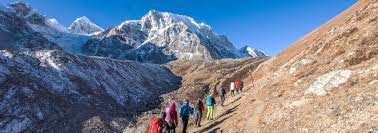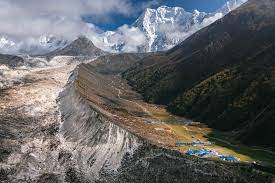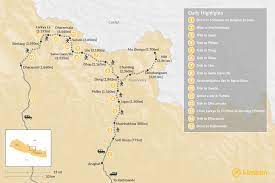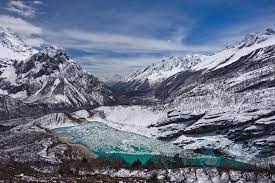Description
Overview :
The Manaslu Circuit Trek in Nepal is a beautiful and off-beaten route. It's one of the most well-liked limited treks in Nepal's Manaslu Region and is arguably the most underappreciated trekking path. The next most captivating destination after Everest, Annapurna, and Langtang is the 14-day Manaslu Trek. It's interesting to note that this is one of the few trekking areas where individuals can go alone on their own, as groups should consist of two persons. Trekking must be supervised by a government-licensed trekking guide from Nepal who also holds an ACAP permission and a special authorization. The eighth-tallest mountain in the world, Mount Manaslu (8163 meters), is a top draw for visitors to the Manaslu area.
Major Highlights:
- Stunning Mountain Views:
The trek offers breathtaking views of the Manaslu massif, including the eighth highest peak in the world, Mount Manaslu (8,163 meters or 26,781 feet). Other prominent peaks visible along the trek include Himlung Himal, Cheo Himal, Kang Guru, and Annapurna II.
- Larkya La Pass:
Crossing the Larkya La Pass at an elevation of 5,160 meters (16,924 feet) is a challenging but rewarding highlight of the trek. The pass provides panoramic views of the surrounding peaks and valleys, making it a memorable and scenic high-altitude experience.
- Cultural Immersion:
The Manaslu Circuit takes you through a variety of ethnic villages, allowing for cultural immersion. You'll encounter diverse communities, including Gurungs, Tibetans, and Magars, each with its own traditions, rituals, and architecture. Villages like Samagaon and Samdo offer a glimpse into the unique local way of life.
- Manaslu Conservation Area:
The trek is part of the Manaslu Conservation Area, home to diverse flora and fauna. The region is a habitat for various wildlife species, including the elusive snow leopard, red panda, Himalayan tahr, and numerous bird species.
- Glimpses of Tibetan Culture:
As the trek is located near the Tibetan border, you'll notice influences of Tibetan culture in the local architecture, monasteries, and daily life. The region has a unique blend of Nepali and Tibetan cultural elements.
- Budhi Gandaki River:
The trek follows the course of the Budhi Gandaki River, crossing it several times via suspension bridges. The river valley adds to the scenic beauty of the trail, with terraced fields, waterfalls, and lush green landscapes.
- Pungyen Gompa:
The trek allows for a visit to Pungyen Gompa, an ancient monastery with religious significance. The monastery offers a serene setting and panoramic views of the surrounding mountains.
Best time to trek:
Trekking the Manaslu Circuit is most enjoyable in the spring (March to May) and fall (September to November). These times of year are ideal for hiking since they have clear skies, steady weather, and temperate temperatures. Avoid the winter (December to February) because of the severe weather and snow-covered paths, and the monsoon season (June to August) because of the intense rainfall.
Detailed Itinerary
Explore our comprehensive day-by-day itinerary to discover the
highlights and activities planned for each day of your trek.
Day 1 Drive from Pokhara to Soti Khola or Arughat
The Manaslu Circuit Trek begins with an 8-10 hour drive from Pokhara to Soti Khola or Arughat, offering stunning Himalayan views and charming villages. Upon arrival, acclimatize to lower elevations, enjoy dinner, and secure permits for the trek. Day 2 begins towards Machha Khola.
Day 2 Soti Khola or Arughat to Machha Khola (900m)
On Day 2 of your Manaslu Circuit Trek, the adventure unfolds as you trek from Soti Khola or Arughat to Machha Khola. Starting early, the trail follows the scenic Budhi Gandaki River, crossing suspension bridges and traversing diverse landscapes of terraced fields and lush forests. You will reach Machha Khola by afternoon, a charming riverside village and can check into a teahouse, explore the surroundings, and enjoy a warm dinner.
Day 3 Machha Khola to Jagat (1,410m)
Today, you'll set out from Machha Khola to Jagat. After a delicious breakfast at the teahouse, your trek will lead you through diverse landscapes, quaint villages, and lush surroundings. Cross scenic suspension bridges and ascend to the charming village of Jagat, arriving in the afternoon. Take in the unique cultural atmosphere, settle into your lodging, and explore the local scene
Day 4 Jagat to Deng (1,804m)
After having breakfast at Jagat, a Tibetan-style settlement, we head towards Philim, another Gurung village. We then continue north through terraced millet fields to Ekle Bhatti. The path becomes steeper, passing through gorges and crossing Budhi Gandaki River. We continue through bamboo forests to the Deng Khola river, crossing it to reach Deng.
Day 5 Deng to Namrung (2,630m)
After breakfast, we head towards Ghap, passing through Bihi Phedi and Bihi. The journey begins with a short descent and sharp ascend to Rana Bridge. We continue through a pine forest and cross a bridge to Bihi Phedi, where we enter a Buddhist region with Mani walls and gods' portraits. We cross another suspension bridge before reaching Ghap. Our final destination today is Namrung, passing through dense forests, steep ascends, suspension bridges, and stone stairs.
Day 6 Namrung to Samagaon (3,530m)
After breakfast, we head towards Lho, a culturally rich village with prayer flags, Mani Walls, and stupas. We cross a stream from Lindanda Glacier to reach Sho, enjoying the views of Simnang Himal. From Lho, we start the early morning trek to Samagaun, passing through a forest and reaching Shyala village. We cross a stream to reach Samagaun, the closest village to Manaslu Base Camp.
Day 7 Acclimatization day in Samagaon
This trek involves acclimatizing to the thin air at Samagaon, a higher elevation. The journey involves exploring Samagaun, observing local lifestyles and culture, and exploring other options like Manaslu Base Camp, Birendra Lake, or Pungyen Monastery. Pungen Monastery, located south of Samagaon, offers stunning views of glaciers and Birendra Tal, a 3,450m glacial lake with thunderous ice blocks. Samagaon is an interesting place for acclimatization.
Day 8 Samagaon to Samdo (3,860m)
The trek today is more enjoyable, crossing pasture areas and ascending to a valley with juniper and birch forests. We cross a wooden bridge over Budhi Gandaki river and climb steeply across it, taking in stunning mountain views, especially Manaslu, before reaching Samdo, a Tibetan refugee village, and exploring its surrounding hills.
Day 9 Samdo to Dharamsala (Larkya Phedi) (4,460m)
Today the journey takes us through fields and old Mani walls, crossing a wooden bridge over the Budhi Gandaki River. We pass Athahra Saya River and Larke River, observing Mani walls and prayer flags. We then visit the magnificent Larkya Glacier, then trek around Salkha Khola valley to reach a stone guest house (4,450m) called Dharamsala or Larkya La Phedi. This day offers stunning views of the Larkya Glacier and Mt. Manaslu.
Day 10 Dharamsala to Bimthang (3,720m) via Larkya La Pass (5,160m)
The journey involves trekking around the Manaslu circuit, crossing the Larkya La Pass (5,100m), and leaving Dharamsala after breakfast. The weather is crucial as it determines the trek's difficulty. The trail starts by crossing the moraine and descending to a small lake. The path is rough and unclear, but marked by prayer flags, we descend to four frozen lakes and climb a steep trail to the Larkya La Pass.
The pass offers panoramic views of Himlung Himal, Cheo Himal, Kang Guru, and Annapurna II. The trail ascends a moraine, crossing it and then descends to a grassy moraine at 4,450m. The trail becomes easier as you reach a small meadow, Mani walls, and small houses at Bhimtang.
Day 11 Bimthang to Dharapani (1,860m)
Today's trek starts with a descent to Budhi Gandaki River and crossing it to enter a rhododendron forest. The trail continues to Karche, a cultivated area near the top of Budhi Gandaki valley. From Gho, the trek continues to Dharapani, a relatively easy descent through fields and pastures. The route ends at Tilje, a Gurung settlement known for brandy, followed by Thonje and Dharapani villages.
Day 12 Dharapani to Syange (1,110m)
Begin your morning with a fulfilling breakfast at your teahouse, embarking on a descent through captivating landscapes and charming villages. The trail unfolds with a mix of terraced fields, verdant forests, and stunning mountain panoramas. By afternoon, you'll reach Syange, where you can check in, absorb the peaceful surroundings, and relax after a day of trekking.
Day 13 Syange to Besisahar (760m) and drive back to Pokhara
Today, you'll journey from Syange to Besisahar and conclude the trek with a drive back to Pokhara. Begin your day with breakfast at the teahouse, and embark on the final leg of your trek, descending through picturesque landscapes and charming villages. Upon reaching Besisahar, your trek officially concludes. From there, you'll take a scenic drive back to Pokhara.



